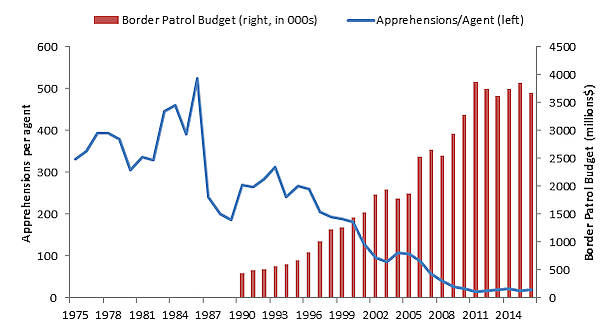One of Donald Trump’s first actions as president was to sign a presidential memorandum freezing federal government employment. But the order specifically exempts certain federal agencies, including all military personnel and all law enforcement. At the same time that he signed this supposed hiring freeze, he also signed an executive order requiring that the hiring of 5,000 new agents for Customs and Border Protection. This increase would ramp up Border Patrol spending to its highest levels ever and do it at a time when the agency is doing less than it has in decades.
First of all, this increase in agents is being proposed a time when the number of border crossers is at record lows. Since 2010, each border agent apprehended fewer than 2 crossers per month, as the figure below shows. This is less than 1 every other week. This figure includes a large number of “apprehensions” of asylum seekers and unaccompanied children who simply turn themselves over to border agents and who made up 1 in 3 apprehensions last year. Thus, the actual number of border crossers that Border Patrol agents needed to race down was just 14 per agent for the entire year. That means that each agent caught on average someone sneaking into the United States once every 26 days in 2016.
At the same time, Congress continues to throw enormous sums at this agency. Border Patrol has spent an average of $172,000 per agent from 2000 to 2016. This amount has fluctuated between a high of $205,000 in 2006 to a low of $146,000 in 2009. The median has been $176,000, and last year’s total was $183,000. Thus, this hiring surge will likely cost almost $1 billion per year. A leaked Border Patrol memo concludes that the costs of “recruiting, hiring, supporting, and training” the new agents will be $328 million in fiscal year 2017 (which ends in October) and $1.884 billion in fiscal year 2018, meaning that the price tag could be even greater than my projection. The GOP Congress has increased the Border Patrol budget in real terms by only $223 million since 2011.
Figure: Apprehensions Per Border Patrol Agent and Border Patrol Budgets (2016$)
Sources: CBP(agents), CBP (apprehensions), CBP (Budgets, PCE-adjusted figures)
Any increase of this magnitude will require special appropriations from Congress, meaning that at most the president’s executive order could speed up the hiring of agents provided by Congress. But even still, Border Patrol has struggled to meet its hiring mandate of 21,380 agents as it is. Since 2012, so many agents are leaving the force that the agency has struggled to keep up. “We are not able to hire as fast as attrition,” CBP Commissioner Gil Kerlikowske told Congress last year. He asked Congress to reduce the mandate by 300.
The Inspector General’s office found last year that Border Patrol and CBP “do not have the staff or comprehensive automated systems needed to hire personnel as efficiently as possible,” finding “significant delays in hiring.” Only 1 in 52 applicants make it through the application process, which makes it difficult to speed up hiring. Last time that Congress pressured the agency to rapidly expand, corners were cut on background checks, and internal corruption reviews were cast aside. About 30 applicants admitted that they were sent by drug cartels.
Border Patrol was still trying in 2015 to cut back on the interview process, and the leaked Border Patrol memo from this month shows the agency is still trying to make it easier to hire people with fewer checks. This is despite the fact that an independent advisory council found just last year that Border Patrol was still “vulnerable to a corruption scandal that could potentially threaten the security of our nation.”
Border security has certainly improved, but when Border Patrol agents are doing as little as they are, Congress should be asking itself whether this agency should receive the funds it is currently getting, not whether it should receive even more. It especially should not consider cutting corners to make hires that the agency cannot guarantee are qualified.

